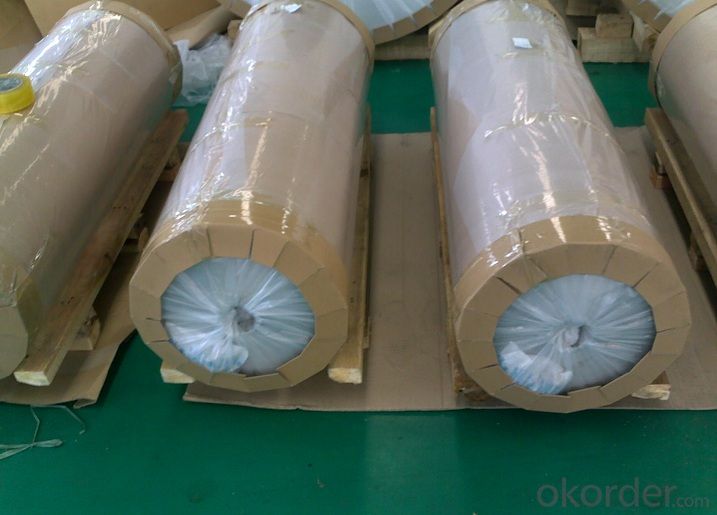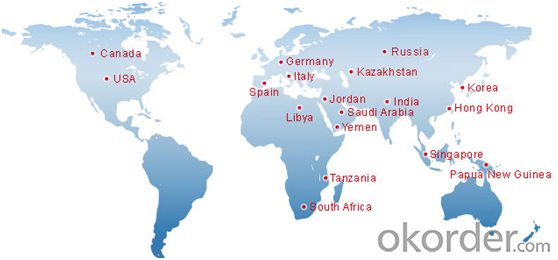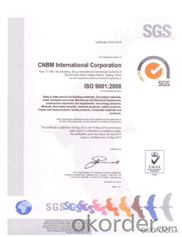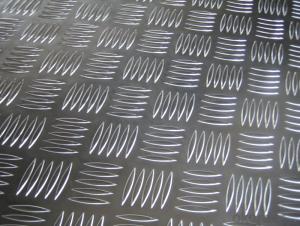High Conductivity Aluminum Strip 1060 O for Transformers - Aluminum Sheets for Enclosed Trailer
- Loading Port:
- Shanghai
- Payment Terms:
- TT OR LC
- Min Order Qty:
- 2.5
- Supply Capability:
- 5000 m.t./month
OKorder Service Pledge
OKorder Financial Service
You Might Also Like
Specification
High Conductivity Aluminium Strip 1060 O for Transformers
l Product Introduction
High conductivity aluminium strip 1060 O for transformers is widely used in transformers,including oil type transformers and dry type transformers. It has good forming property,high corrosion resistance, good weldability and conductivity.
There is no burr on the edge of high conductivity aluminium strip 1060 O. Surface automization treatment makes high conductivity aluminium strip 1060 O surface get to a brighter and cleaner level.
High conductivity aluminium strip 1060 O quality has always been to maintain industry leading position with the domestic leading technology. Rational design and renovation without changing the precision of the 1250 highspeed slitting line make the height of burr less than 0.01 mm and the side camber lower than the standard of industry to enhance the commonality, processing capacity and scope also increase accordingly.
l Packaging & Delivery
Packaging detail: Covering with brown paper and plastic bag then packed with wooden plywood then directly loading into container for transshipment. For the thickness which is more than 1.50mm, one paper interleave into two sheets.
Delivery detail: within 25 days

l Company Profile
CNBM International Corporation, China National Building Materials (Group) Corporation, is one of the largest companies in China building material & equipment industry, with 42,800 employees and sales in 2005 of US Dollar 4.395 billion. In 2006, China National Building Material Company Limited was listed on Hong Kong Stock Market with the stock code as 3323.
Aluminium Strip has always been one of the most popular products in CNBM. With advanced technic skills and equipment, CNBM has produced high quality aluminium strips that meet international standard.

l Product Images



l Certificates



l FAQ
Q: Do you provide free samples?
A: Yes, free samples will be sent to you on freight at destination.
Q: Can I get your latest products catalogue?
A: Yes, it will be sent to you in no time.
Q: What is the MOQ?
A: 2.5 tons
Q: What are your payment terms?
A: We accept L/C, T/T.
- Q: What can I do to remove the paint from the painted aluminum sheet?
- Aluminum sheet refers to the rectangular plate made of aluminium ingot rolled and divided into pure aluminum plate, alloy aluminum plate, thin aluminum plate, middle thick aluminum plate and pattern aluminum plate.
- Q: Are the aluminum sheets suitable for manufacturing food processing equipment?
- Aluminum sheets, indeed, prove to be fitting for the production of food processing equipment. This metal, lightweight and enduring, possesses resistance against corrosion, rendering it exceptionally suitable for deployment within the food industry. Moreover, aluminum is free from toxicity, odorlessness, and devoid of any detrimental impact on the flavor or excellence of the processed food. Furthermore, aluminum can be effortlessly cleansed and maintained, thus guaranteeing adherence to hygiene guidelines. Additionally, owing to its capacity to proficiently conduct heat, aluminum serves as an apt choice for cooking and baking applications. All in all, the myriad advantageous attributes of aluminum sheets establish them as a widely favored option for the manufacture of food processing equipment.
- Q: Are aluminum sheets suitable for high-pressure environments?
- In high-pressure environments, aluminum sheets are generally unsuitable due to their relatively low strength-to-weight ratio compared to other materials. Consequently, there is a potential for deformation or failure under high pressure, posing safety risks. Moreover, aluminum's structural integrity is further compromised in these situations due to its relatively low melting point. Therefore, materials like steel or titanium, which offer greater strength and resistance to deformation, are typically preferred in such environments.
- Q: This question asks about the distinctions between aluminum sheets that are produced domestically versus those that are imported.
- <p>Yes, there can be differences between domestic and imported aluminum sheets. These differences may include quality standards, material composition, thickness, surface finish, and price. Domestic sheets are often produced to meet local standards and regulations, while imported sheets may adhere to different international standards. The manufacturing process and raw materials used can also vary, leading to differences in durability, strength, and workability. Additionally, imported sheets might have different certifications or come from countries with lower production costs, which can affect the price. However, it's important to note that not all imported aluminum sheets are of lower quality; some may be of higher quality or have specific characteristics that are not available domestically.</p>
- Q: Can aluminum sheets be used for chemical pumps?
- No, aluminum sheets are not suitable for chemical pumps as they are not resistant to corrosion from many chemicals.
- Q: Is it suitable to use aluminum windows in areas with cold weather conditions?
- <p>Yes, you can use aluminum windows in cold climates, but there are considerations. Aluminum is a good conductor of heat, which can lead to heat loss in cold weather. To mitigate this, insulated glass units and thermally broken frames can be used. These designs slow down heat transfer, making aluminum windows more energy-efficient in cold climates. Additionally, proper sealing and weatherstripping are crucial to prevent drafts and ensure the windows perform well in low temperatures.</p>
- Q: Can aluminum sheets be welded?
- Indeed, welding aluminum is a possibility. Aluminum, being a versatile material, lends itself well to welding through the utilization of different techniques like Tungsten Inert Gas (TIG) welding, Metal Inert Gas (MIG) welding, and Gas Metal Arc Welding (GMAW). However, it is important to note that welding aluminum requires special considerations due to its unique properties in comparison to other metals. Aluminum possesses a low melting point and high thermal conductivity, necessitating a higher heat input and faster welding speed when compared to other metals. Additionally, there is the swift formation of aluminum oxide on the surface, which mandates the removal of this oxide layer prior to welding. To ensure a proper weld quality, specialized welding techniques such as alternating current in TIG welding or the usage of a spool gun in MIG welding are often employed. All in all, with the correct techniques and equipment, aluminum sheets can indeed be welded successfully, making it a favored choice in industries including automotive, aerospace, and construction.
- Q: What are the different types of coatings available for aluminum sheets?
- There are several different types of coatings available for aluminum sheets, each offering unique properties and benefits. 1. Anodized Coating: Anodizing is a popular coating method that involves immersing the aluminum sheet in an electrolyte bath and passing an electric current through it. This process creates a durable and corrosion-resistant layer of oxide on the surface of the sheet. Anodized coatings can come in various colors and offer excellent abrasion resistance. 2. Powder Coating: Powder coating involves applying a dry powder to the aluminum sheet and then curing it under heat. This coating method provides a durable, uniform, and attractive finish. Powder coatings are available in a wide range of colors and textures and offer excellent resistance to chipping, scratching, and UV fading. 3. Paint Coating: Aluminum sheets can also be coated with liquid paint. This method provides versatility in terms of color choices and finishes. Paint coatings offer good resistance to weathering, impact, and chemicals, but they may not be as durable as anodized or powder coatings. 4. Cladding: Cladding is a process in which a layer of a different metal, such as stainless steel or copper, is bonded to the aluminum sheet surface. This provides added protection, improved aesthetic appeal, and can enhance the sheet's mechanical properties. 5. Laminating: Laminating involves bonding a protective layer, such as a film or sheet, onto the surface of the aluminum sheet. This coating method offers protection against abrasion, UV rays, and chemicals, and can also provide decorative finishes. 6. Organic Coating: Organic coatings, such as polyurethane or acrylic coatings, are applied to aluminum sheets to provide protection against corrosion, weathering, and chemical exposure. These coatings offer flexibility, good adhesion, and a wide range of color choices. Overall, the choice of coating for aluminum sheets depends on the specific requirements of the application, such as durability, corrosion resistance, aesthetic appeal, and cost-effectiveness.
- Q: Can aluminum sheet be used for cookware?
- Yes, aluminum sheet can be used for cookware. Aluminum is a popular choice for cookware due to its excellent heat conductivity, which allows for even heat distribution and quick heating. It is lightweight, durable, and resistant to rust and corrosion. Additionally, aluminum cookware is affordable and relatively easy to clean. However, pure aluminum is a soft metal, so it is often combined with other materials, such as stainless steel or nonstick coatings, to enhance its durability and nonstick properties.
- Q: Can aluminum sheets be used for reflective insulation?
- Indeed, reflective insulation can make use of aluminum sheets. With their high reflectivity and impressive thermal conductivity, aluminum proves to be an exceptional option for effectively reflecting heat and minimizing heat transfer. By employing aluminum sheets as insulation, heat can be effectively redirected away from the surface, effectively preventing its entry or escape from the desired space. This proves to be advantageous in maintaining a cozy temperature indoors or safeguarding delicate equipment against extreme temperatures. Moreover, the lightweight nature and ease of installation of aluminum sheets further contribute to their popularity in reflective insulation applications.
Send your message to us
High Conductivity Aluminum Strip 1060 O for Transformers - Aluminum Sheets for Enclosed Trailer
- Loading Port:
- Shanghai
- Payment Terms:
- TT OR LC
- Min Order Qty:
- 2.5
- Supply Capability:
- 5000 m.t./month
OKorder Service Pledge
OKorder Financial Service
Similar products
Hot products
Hot Searches
Related keywords




























